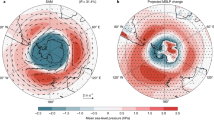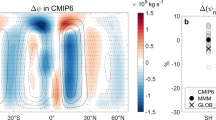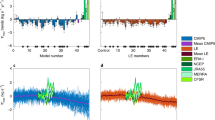Abstract
THE temperature in the vicinity of the tropical tropopause is lower in January than in July (ref. 1 and our unpublished results), the difference ranging to about 10° C in the 100–50 mbar layer (about 16–21 km). The low temperature depends on the calendar year rather than on mean zenith angle of the Sun, because it occurs in either January or February at tropical stations in both hemispheres (our unpublished results). Concomitantly the tropopause itself is higher at these times. The air near the tropopause is kept cold chiefly by the adiabatic cooling produced by rising motions in the tropical Hadley cell circulation2, the contribution by horizontal motions carrying heat away from tropical regions being relatively small3. The adiabatic cooling is balanced by radiative heating, and Kennedy4 has shown that the main component here is a convergence of radiative flux in the 15 micron carbon dioxide band. At the tropopause itself this infrared component produces heating because the carbon dioxide both above and below is warmer. From either Kennedy's work or more recent radiative heating calculations by Rodgers5 the heating rate is about 0.25° C/day which, together with an observed horizontal heat flux divergence of about 0.05° C/day, leads to a rising motion necessary for balance3 of about 0.02 cm s−1. Similar conclusions about the physical factors governing the tropopause temperature have recently been reached from a numerical model study by Manabe and Hunt6. An important point from Rodgers's results is that the total heating rate at the tropopause is essentially the same in January and July within the limits of accuracy of the calculations.
This is a preview of subscription content, access via your institution
Access options
Subscribe to this journal
Receive 51 print issues and online access
$199.00 per year
only $3.90 per issue
Buy this article
- Purchase on Springer Link
- Instant access to full article PDF
Prices may be subject to local taxes which are calculated during checkout
Similar content being viewed by others
References
Goldie, N., Moore, J. G., and Austin, E. E., Geophys. Mem., No. 101, 228 (1958).
Brewer, A. W., Quart. J. Roy. Meteorol. Soc., 75, 351 (1949).
Newell, R. E., Vincent, D. G., and Kidson, J. W., Tellus (in the press).
Kennedy, J. S., MIT Dept. Meteorol. Rep., No. 11, 116 (1964).
Rodgers, C. D., MIT Dept. Meteorol. Rep., No. A2, 99 (1967).
Manabe, S., and Hunt, B. G., Mon. Weather Rev., 96, 447 (1968).
Manabe, S., and Smagorinsky, J., Mon. Weather Rev., 95, 155 (1967).
Angell, J. K., and Korshover, J., J. Atmos. Sci., 21, 479 (1964).
Reed, R. J., Bull. Amer. Meteorol. Soc., 46, 374 (1965).
Belmont, A. D., and Dartt, D. G., J. Atmos. Sci., 21, 354 (1964).
Wallace, J. M., and Newell, R. E., Quart. J. Roy. Meteorol. Soc., 92, 481 (1966).
Bjerknes, J., Tellus, 18, 820 (1966).
Reed, R. J., and Vlcek, C. L., J. Atmos. Sci. (in the press).
Author information
Authors and Affiliations
Rights and permissions
About this article
Cite this article
NEWELL, R., KIDSON, J. & VINCENT, D. Annual and Biennial Modulations in the Tropical Hadley Cell Circulation. Nature 222, 76–78 (1969). https://doi.org/10.1038/222076a0
Received:
Issue Date:
DOI: https://doi.org/10.1038/222076a0
This article is cited by
-
Climate and the Galapagos Islands
Nature (1973)
-
Water Vapour Pollution in the Stratosphere by the Supersonic Transporter ?
Nature (1970)
Comments
By submitting a comment you agree to abide by our Terms and Community Guidelines. If you find something abusive or that does not comply with our terms or guidelines please flag it as inappropriate.



